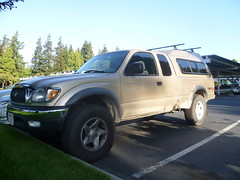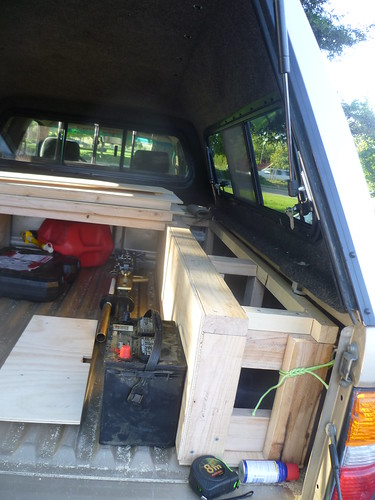Jack the Camper
2011-06-08
So, we bought Jack (our pick up truck) with a very specific purpose in mind.
Okay, not that specific, but basically, we wanted to make him into a sortof - very basic off-road camper. Jack is to campers as ultralight backpacking is to traditional backpacking.
As we mentioned in a previous post, the idea was to build a platform in the back, sortof like the image below:
http://www.swaygogear.com/articles/truckcamping/
But, we had a few ideas of our own. In particular, we wanted something where we could easilly use the truck as... well... a truck. In our current lifestyle we are not nomadic, so this conversion needs to be dual purpose. That said, we have a lot of gear that we want to keep in the truck basically all of the time. Examples include basic repair and recovery gear for the truck, and some simple camping gear.
See Jack the Truck for the planned list.
So, we devised the idea of building boxes down the sides about the size of the wheel-wells. I designed something, went out and bought the wood. While discussing it Jess thought she had a better idea and designed something somewhat lighter. We went back and forth and after a few iterations (and a bit of bickering) mostly had something we were happy with - with Jess making a few more modifications during construction.
And here is the result:
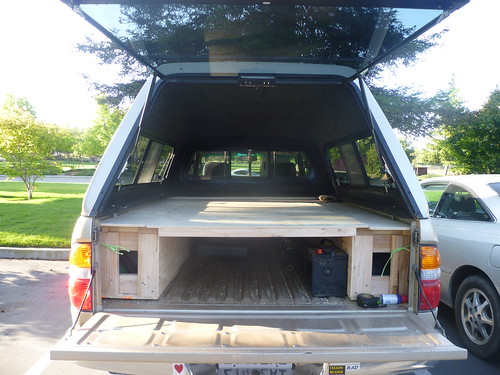
The boxes are screwed together with coated deck-screws. They're built of 2x4 and 2x2. All the ply is 1/4". You can see from the photo how the end is constructed - a simple cross-brace. This was Jess' idea to make them super-sturdy without too much extra weight.
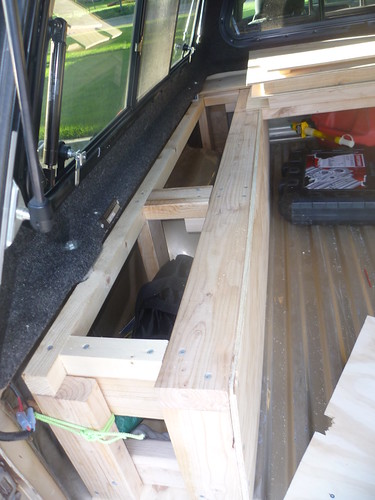
Here you can see that the inside top of the box is 2x4 and the outside is 2x2. We wanted plenty of lap space for the ply top on the 2x4 so that the boxes could have a little "play" in terms of bed position without the panels we're lying on dropping to the floor. This necessitated the slightly complex construction of the center cross piece screwed into a block, as we didn't want to waste the extra weight of a more complete support structure
Future improvements:
http://www.swaygogear.com/articles/truckcamping/
But, we had a few ideas of our own. In particular, we wanted something where we could easilly use the truck as... well... a truck. In our current lifestyle we are not nomadic, so this conversion needs to be dual purpose. That said, we have a lot of gear that we want to keep in the truck basically all of the time. Examples include basic repair and recovery gear for the truck, and some simple camping gear.
See Jack the Truck for the planned list.
So, we devised the idea of building boxes down the sides about the size of the wheel-wells. I designed something, went out and bought the wood. While discussing it Jess thought she had a better idea and designed something somewhat lighter. We went back and forth and after a few iterations (and a bit of bickering) mostly had something we were happy with - with Jess making a few more modifications during construction.
And here is the result:

The boxes are screwed together with coated deck-screws. They're built of 2x4 and 2x2. All the ply is 1/4". You can see from the photo how the end is constructed - a simple cross-brace. This was Jess' idea to make them super-sturdy without too much extra weight.

Here you can see that the inside top of the box is 2x4 and the outside is 2x2. We wanted plenty of lap space for the ply top on the 2x4 so that the boxes could have a little "play" in terms of bed position without the panels we're lying on dropping to the floor. This necessitated the slightly complex construction of the center cross piece screwed into a block, as we didn't want to waste the extra weight of a more complete support structure
The bottom of the each box is 2 pieces of quarter inch ply, one for and one aft of the wheel well. On the inside bottom a 2x4 is screwed on edge to the ply, running nearly flush with the wheel well, on the outside the vertical supports are screwed straight to the ply. The 2x4 on the inside bottom is to add stiffness so the box will support it's own weight when being moved into and out of the truck. We don't expect to move the boxes much, but we wanted it to be possible.
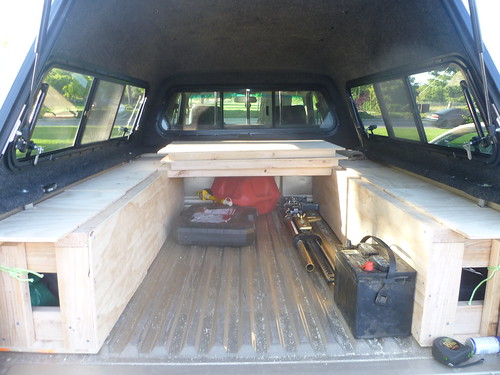
In the end we're really happy with how the rig came out. You can see it's pretty easy to get into the boxes from lying on the platform. The lids have pieces of wood on the bottom, so they're held somewhat in place. Moving the platorms aside is trivial, they slide fairly freely down the "tracks" made by the boxes.
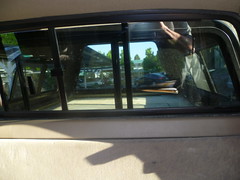
Removing the front window it's possible to get from the cap to the cab without leaving the truck, it's suboptimal, but possible. After much research and consideration we decided a "boot" connecting the cab to the cap was a bad idea, and that we could live with this setup.

In the end we're really happy with how the rig came out. You can see it's pretty easy to get into the boxes from lying on the platform. The lids have pieces of wood on the bottom, so they're held somewhat in place. Moving the platorms aside is trivial, they slide fairly freely down the "tracks" made by the boxes.

Removing the front window it's possible to get from the cap to the cab without leaving the truck, it's suboptimal, but possible. After much research and consideration we decided a "boot" connecting the cab to the cap was a bad idea, and that we could live with this setup.
Note the "windoors" on the cap. This makes getting to the side boxes even easier when the truck is full. They also give great ventilation if gasoline was stored in the back, or just for a nice night out. Additionally they also have sliders so we can ventilate the bed while driving.
Future improvements:
-
Velcro edged black velvety cloth to hang over the windows. The hope is that in the dark or if no-one looks too closely it'll read as heavily tinted windows. This is both for "stealth" camping, as well as general purpose curtains.
-
Velco edging on the lids. The idea is to velcro down the lids with a layer between the box and lid so that they don't rattle and bounce around while we're driving, especially useful on rutted dirt roads.
- Improved tie-downs. Right now the boxes are tied in place on each cover to the bed tie-downs with heavy twine. This is okay - but something a bit heftier like webbing would be better.
- Some form of mattress or pad either rollable, foldable, or attached individually to each panel. We haven't decided yet, so we'll just use backpacking matts for the time being.
More photos


